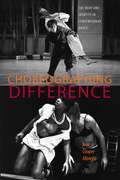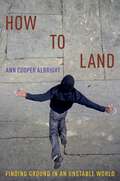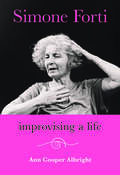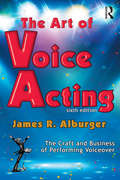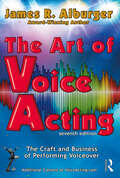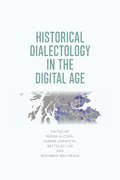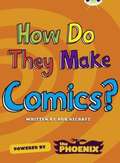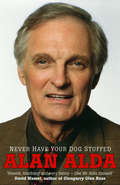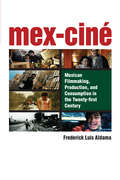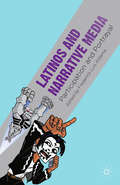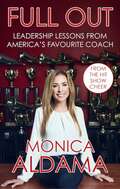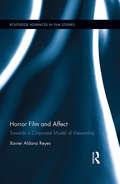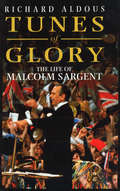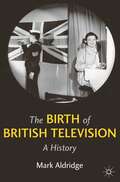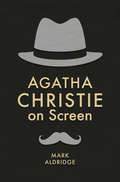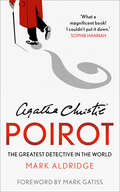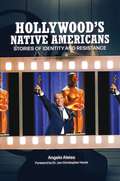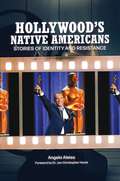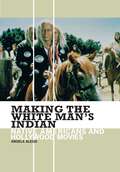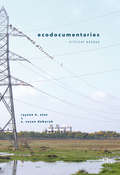- Table View
- List View
Choreographing Difference: The Body and Identity in Contemporary Dance
by Ann Cooper AlbrightThe choreographies of Bill T. Jones, Cleveland Ballet Dancing Wheels, Zab Maboungou, David Dorfman, Marie Chouinard, Jawole Willa Jo Zollar, and others, have helped establish dance as a crucial discourse of the 90s. These dancers, Ann Cooper Albright argues, are asking the audience to see the body as a source of cultural identity — a physical presence that moves with and through its gendered, racial, and social meanings.Through her articulate and nuanced analysis of contemporary choreography, Albright shows how the dancing body shifts conventions of representation and provides a critical example of the dialectical relationship between cultures and the bodies that inhabit them. As a dancer, feminist, and philosopher, Albright turns to the material experience of bodies, not just the body as a figure or metaphor, to understand how cultural representation becomes embedded in the body. In arguing for the intelligence of bodies, Choreographing Difference is itself a testimonial, giving voice to some important political, moral, and artistic questions of our time.
How to Land: Finding Ground in an Unstable World
by Ann Cooper AlbrightHow to Land: Finding Ground in an Unstable World foregrounds the importance of embodiment as a means of surviving the disorientation of our twenty-first century world. Linking somatics and politics, author Ann Cooper Albright argues that a renewed attention to gravity as both a metaphoric sensibility and a physical experience can help transform moments of personal disorientation into an opportunity to reflect on the important relationship between individual resiliency and communal responsibility. Long one of the nation's preeminent thinkers in dance studies, Albright asks how contemporary bodies are affected by repeated images of falling bodies, bombed-out buildings, and displaced peoples, as well as recurring evocations of global economies and governments in discursive free fall or dissolution. What kind of fear gets lodged in connective tissue when there is an underlying anxiety that certain aspects of our world are in danger of falling apart? To answer this question, she draws on analyses of perception from cognitive studies, tracing the discussions of meaning, body and language through the work of Sara Ahmed, Jean-Luc Nancy, and Shaun Gallagher, among others. In addition, she follows the past decade of debate in contemporary media concerning the implications of the weightless and two-dimensional social media exchanges on structures of attention and learning, as well as their effect on the personal growth and socialization of a generation of young adults. Each chapter interweaves discussions of movement actions with their cultural implications, documenting specific bodily experiences and then tracing their ideological ripples out through the world.
HOW TO LAND C: Finding Ground in an Unstable World
by Ann Cooper AlbrightHow to Land: Finding Ground in an Unstable World foregrounds the importance of embodiment as a means of surviving the disorientation of our twenty-first century world. Linking somatics and politics, author Ann Cooper Albright argues that a renewed attention to gravity as both a metaphoric sensibility and a physical experience can help transform moments of personal disorientation into an opportunity to reflect on the important relationship between individual resiliency and communal responsibility. Long one of the nation's preeminent thinkers in dance studies, Albright asks how contemporary bodies are affected by repeated images of falling bodies, bombed-out buildings, and displaced peoples, as well as recurring evocations of global economies and governments in discursive free fall or dissolution. What kind of fear gets lodged in connective tissue when there is an underlying anxiety that certain aspects of our world are in danger of falling apart? To answer this question, she draws on analyses of perception from cognitive studies, tracing the discussions of meaning, body and language through the work of Sara Ahmed, Jean-Luc Nancy, and Shaun Gallagher, among others. In addition, she follows the past decade of debate in contemporary media concerning the implications of the weightless and two-dimensional social media exchanges on structures of attention and learning, as well as their effect on the personal growth and socialization of a generation of young adults. Each chapter interweaves discussions of movement actions with their cultural implications, documenting specific bodily experiences and then tracing their ideological ripples out through the world.
Simone Forti: Improvising a Life
by Ann Cooper AlbrightSimone Forti, groundbreaking improvisor, has spent a lifetime weaving together the movement of her mind with the movement of her body to create a unique oeuvre situated at the intersection of dancing and art practices. Her seminal Dance Constructions from the 1960s crafted a new approach to dance composition and helped inspire the investigations of Judson Dance Theater. In the 1970s, Forti's explorations of animal movements expanded that legacy to launch improvisation as a valuable artform in its own right. From her early forays into vocal accompaniment to her News Animations, Forti has long integrated gesture and text into compelling performances that consistently stretched the boundaries of dance to layer abstract movement with story-telling and political commentary. Her "Land Portraits" series brought an immersive ecological experience to New York City stages in the 1980s, and she is a beloved teacher and mentor whose Body, Mind, World workshops have inspired dancers around the world. In this beautifully written book, author Ann Cooper Albright braids archival research, extensive interviews, and detailed movement analyses of Forti's performances to provide the first kinesthetically-informed and critically-nuanced history of Forti's multifaceted and extensive career.Publication of this book is funded by the Beatrice Fox Auerbach Foundation Fund at the Hartford Foundation for Public Giving.
The Art of Voice Acting: The Craft and Business of Performing for Voiceover
by James AlburgerThe Art of Voice Acting covers all aspects of the craft and business of performing voiceover. This sixth edition is reorganized and completely updated to include the latest information on how to get started in voiceover, performing techniques, setting up a personal recording space, voiceover demos, the basics of running a voiceover business, working with agents, unions, and much more. Dozens of URL’s are included with additional resources and several chapters include all new scripts written specifically for this edition. Two new chapters include contributions from some of the voiceover world’s top professionals. Additional content can be found on the Voice Acting Academy website at AOVA.VoiceActing.com. This is the perfect tool for aspiring voice performers, radio announcers, and stage and screen actors.
The Art of Voice Acting: The Craft and Business of Performing for Voiceover
by James AlburgerThe Art of Voice Acting covers all aspects of the craft and business of performing voiceover. This sixth edition is reorganized and completely updated to include the latest information on how to get started in voiceover, performing techniques, setting up a personal recording space, voiceover demos, the basics of running a voiceover business, working with agents, unions, and much more. Dozens of URL’s are included with additional resources and several chapters include all new scripts written specifically for this edition. Two new chapters include contributions from some of the voiceover world’s top professionals. Additional content can be found on the Voice Acting Academy website at AOVA.VoiceActing.com. This is the perfect tool for aspiring voice performers, radio announcers, and stage and screen actors.
The Art of Voice Acting: The Craft and Business of Performing for Voiceover
by James R. AlburgerNow in its seventh edition, The Art of Voice Acting covers all aspects of the craft and business of performing voiceover. Starting with the basics of voice acting, every aspect of the craft and business of performing voiceover is explained in detail, including how to get started, performing techniques, setting up a personal recording space, voiceover demos, the basics of running a voiceover business, unions and much, much more. This edition is completely updated with all new scripts, discussions of the latest trends in voiceover and contributions from some of the voiceover industry’s top performers, casting directors and agents. The book provides a wealth of practical information that can be put to work immediately, as well as hundreds of references to websites and other useful resources. Anyone interested in acting, storytelling, any area of voiceover or simply improving verbal communication skills will benefit from this book. Although The Art of Voice Acting is a great learning tool for the beginner, it will also serve the experienced performer well as a reminder of performing and business tools that are essential in today’s world of acting and voiceover. Additional content, including scripts, audio files, and unpublished content can be found at www.AOVA.VoiceActing.com.
The Art of Voice Acting: The Craft and Business of Performing for Voiceover
by James R. AlburgerNow in its seventh edition, The Art of Voice Acting covers all aspects of the craft and business of performing voiceover. Starting with the basics of voice acting, every aspect of the craft and business of performing voiceover is explained in detail, including how to get started, performing techniques, setting up a personal recording space, voiceover demos, the basics of running a voiceover business, unions and much, much more. This edition is completely updated with all new scripts, discussions of the latest trends in voiceover and contributions from some of the voiceover industry’s top performers, casting directors and agents. The book provides a wealth of practical information that can be put to work immediately, as well as hundreds of references to websites and other useful resources. Anyone interested in acting, storytelling, any area of voiceover or simply improving verbal communication skills will benefit from this book. Although The Art of Voice Acting is a great learning tool for the beginner, it will also serve the experienced performer well as a reminder of performing and business tools that are essential in today’s world of acting and voiceover. Additional content, including scripts, audio files, and unpublished content can be found at www.AOVA.VoiceActing.com.
Historical Dialectology in the Digital Age
by Rhona Alcorn Joanna Kopaczyk10 critical essays challenge speculative realism from perspectives from German idealism to phenomenology and deconstruction
Historical Dialectology in the Digital Age
by Rhona Alcorn Joanna KopaczykExamines how pre-modernist conceptions and social organizations of pleasure have impacted post-WWII film
Bug Club, Blue, A: How Do They Make Comics? (PDF)
by Rob AlcraftPart of the Bug Club whole school reading programme for Reception, KS1 and KS2 that transforms young readers into life-long readers. Children are instantly engaged by the characters they know and love and want to read more and more.
Never Have Your Dog Stuffed: And Other Things I've Learned
by Alan AldaHe's one of America's most recognisable and acclaimed actors-a star on Broadway, an Oscar nominee for The Aviator, and the only person to ever win Emmys for acting, writing, and directing during his eleven years on M*A*S*H. Now Alan Alda has written a memoir as elegant, funny, and affecting as his greatest performances. 'My mother didn't try to stab my father until I was six,' begins Alan Alda's irresistible story. The son of a popular actor and a loving, but mentally ill mother, he spent his early childhood backstage in the erotic and comic world of burlesque and went on after early struggles to achieve extraordinary success in his profession.Yet Never Have Your Dog Stuffed is not a memoir of show business ups and downs. It is a moving and funny story of a boy growing into a man who then realizes he has only begun to grow. It is the story of turning points in his life, events that would make him what he is - if only he could survive them.From the moment as a boy when his dead dog is returned from the taxidermist's shop with a hideous expression on his face, and he learns that death can't be undone, to the decades-long effort to find compassion for the mother he lived with but never knew, to his acceptance of his father in him, personally and professionally, he learns the hard way that change, uncertainty and transformation are what life is made of, and the good life is made of welcoming them.Never Have Your Dog Stuffed, filled with curiosity about Nature, good humour and honesty, is the crowning achievement of an actor, author, and director, but surprisingly, it is the story of a life more filled with turbulence and laughter than any he's ever played on the stage or screen.
Mex-Ciné: Mexican Filmmaking, Production, and Consumption in the Twenty-first Century
by Frederick L AldamaMex-Cinéoffers an accessibly written, multidisciplinary investigation of contemporary Mexican cinema that combines industrial, technical, and sociopolitical analysis with analyses of modes of reception through cognitive theory. Mex-Cinéaims to make visible the twenty-first century Mexican film industry, its blueprints, and the cognitive and emotive faculties involved in making and consuming its corpus. A sustained, free-flowing book-length meditation, Mex-Ciné enriches our understanding of the way contemporary Mexican directors use specific technical devices, structures, and characterizations in making films in ways that guide the perceptual, emotive, and cognitive faculties of their ideal audiences, while providing the historical contexts in which these films are made and consumed.
Latinos and Narrative Media: Participation and Portrayal
by Frederick Luis AldamaThis is the first book to explore the multitude of narrative media forms created by and that feature Latinos in the twenty-first century - a radically different cultural landscape to earlier epochs. The essays present a fresh take informed by the explosion of Latino demographics and its divergent cultural tastes.
Full Out: Leadership lessons from America's favourite coach
by Monica AldamaFrom the breakout star of Netflix's Cheer, a motivational and inspiring guide to becoming a champion in all areas of life.In Full Out, Coach Monica Aldama shares how she built one of the most successful and beloved cheerleading programs in America. Her uncompromising brand of discipline and consistency goes far beyond the mat - showing how the principles of building a winning team apply to personal goals, the corporate world, parenting and all aspects of life.There's a lot of talk these days about short cuts and life hacks, but what really counts is commitment and integrity, helping your friends, and improving with your teammates. Coach Monica shares deeply personal stories of triumph and tragedy from divorce and remarriage to her husband, her challenges as a young mother working more than full time, and her strenuous weeks on Dancing with the Stars. She shares surprising behind-the-scenes moments from the Cheer docuseries, and insights gleaned from more than two decades of pushing students to succeed. A true force and inspiration who has captured hearts around the world, Coach Monica will show you how to take command of your talent, make the most of your potential, and find your drive to win.
Horror Film and Affect: Towards a Corporeal Model of Viewership (Routledge Advances in Film Studies)
by Xavier Aldana ReyesThis book brings together various theoretical approaches to Horror that have received consistent academic attention since the 1990s – abjection, disgust, cognition, phenomenology, pain studies – to make a significant contribution to the study of fictional moving images of mutilation and the ways in which human bodies are affected by those on the screen on three levels: representationally, emotionally and somatically. Aldana Reyes reads Horror viewership as eminently carnal, and seeks to articulate the need for an alternative model that understands the experience of feeling under corporeal threat as the genre’s main descriptor. Using recent, post-millennial examples throughout, the book also offers case studies of key films such as Hostel, [REC], Martyrs or Ginger Snaps, and considers contemporary Horror strands such as found footage or 3D Horror.
Horror Film and Affect: Towards a Corporeal Model of Viewership (Routledge Advances in Film Studies)
by Xavier Aldana ReyesThis book brings together various theoretical approaches to Horror that have received consistent academic attention since the 1990s – abjection, disgust, cognition, phenomenology, pain studies – to make a significant contribution to the study of fictional moving images of mutilation and the ways in which human bodies are affected by those on the screen on three levels: representationally, emotionally and somatically. Aldana Reyes reads Horror viewership as eminently carnal, and seeks to articulate the need for an alternative model that understands the experience of feeling under corporeal threat as the genre’s main descriptor. Using recent, post-millennial examples throughout, the book also offers case studies of key films such as Hostel, [REC], Martyrs or Ginger Snaps, and considers contemporary Horror strands such as found footage or 3D Horror.
Tunes Of Glory: The Life of Malcolm Sargent
by Richard AldousA worldwide television audience of millions saw England's most famous maestro take his poignant farewell at the 1967 Last Night of the Proms just weeks before his death. The brush-haired boy from the gasworks of Stamford had become Sir Malcolm Sargent, the nation's 'ambassador with a baton' and friend to royalty. Sleek and debonair, a carnation ever-present in his lapel, Sargent was despised by the musicalestablishment for his populism and showmanship. Yet ordinary music-lovers had been devoted to him, not least for his heroics during the Blitz. 'Flash Harry' is as much an exploration of celebrity and the English psyche as the story of one man. It is the defining work on an extraordinary life drawn from the author's exclusive and unlimited access to Sargent's private letters, photographs and diaries.
The Birth of British Television: A History
by M. AldridgeWhen the BBC launched the world's first regular, high-definition television service on 2 November, 1936 it was the culmination of decades of technological innovations. More than this, however, the service meant that the principle of television had finally found its place. The Birth of British Television – A History traces the early history and development of television, from the experiments of amateurs to the institutionalised developments that led to the world's first regular, high definition television service. Author Mark Aldridge provides a clear, in-depth and accessible introduction for those either exploring the period for the first time or seeking new insights into the beginnings of the industry. In tracing the origins and development of television, Aldridge focuses on a number of important factors including the attitude of the press towards early television and examines the way that expectations of television changed over time prior to its official launch. Utilising new research, this illuminating study examines how the aims for a new television service developed, and the extent to which content and technology were linked. The Birth of British Television approaches this formative period from several perspectives, from private individuals to the BBC and government, while also examining the broader opinions at the time towards the new medium through press reports and feedback from the general public. Also included is an assessment of early programming, which helps to offer a new and profound evaluation of the development of early television. Mark Aldridge is a Lecturer in Film and TV Studies at Southampton Solent University, UK. He specialises in British television and both film and television history. His previous publications include T is for Television (2008), an analysis of the work of Russell T. Davies, co-written with Andy Murray.
Agatha Christie on Screen (Crime Files)
by Mark AldridgeThis book is a comprehensive exploration of 90 years of film and television adaptations of the world’s best-selling novelist’s work. Drawing on extensive archival material, it offers new information regarding both the well-known and forgotten screen adaptations of Agatha Christie’s stories, including unmade and rare adaptations, some of which have been unseen for more than half a century. This history offers intriguing insights into the discussions and debates that surrounded many of these screen projects – something that is brought to life through previously unpublished correspondence from Christie herself and a new wide-ranging interview with her grandson, Mathew Prichard. Agatha Christie on Screen takes the reader on a journey from little known silent film adaptations, through to famous screen productions including 1974’s Murder on the Orient Express, as well as the television series of the Poirot and Miss Marple stories and, most recently, the BBC’s acclaimed version of And Then There Were None.
Agatha Christie’s Poirot: The Greatest Detective In The World
by Mark AldridgeFrom the very first book publication in 1920 to the film release of Death on the Nile in December 2020, this investigation into Agatha Christie’s Hercule Poirot celebrates a century of probably the world’s favourite fictional detective.
Hollywood's Native Americans: Stories of Identity and Resistance (Non-ser.)
by Angela AleissThis book highlights the contributions and careers of Native Americans who have carved impressive careers in Hollywood, from the silent film era of the early 1900s to the present, becoming advocates for their heritage.This book explores how the heritage and behind-the-scenes activities of Native American actors and filmmakers helped shape their own movie images. Native artists have impacted movies for more than a century, but until recently their presence had passed largely unrecognized. From the silent era to contemporary movies, this book features leading Native American actors whose voices have reached a broad audience and are part of the larger conversation about the exploitation of underrepresented people in Hollywood.Each chapter highlights Native actors in lead or supporting roles as well as filmmakers whose movies were financed and distributed by Hollywood studios. The text further explores how a "pan-Indian heritage" that applies to all tribes in terms of spirituality, historical trauma, and a version of ceremony and storytelling have shaped these performers' movie identities. It will appeal to a wide range of readers, including fans of Westerns, history buffs of American popular cinema, and students and scholars of Native American studies.
Hollywood's Native Americans: Stories of Identity and Resistance
by Angela AleissThis book highlights the contributions and careers of Native Americans who have carved impressive careers in Hollywood, from the silent film era of the early 1900s to the present, becoming advocates for their heritage.This book explores how the heritage and behind-the-scenes activities of Native American actors and filmmakers helped shape their own movie images. Native artists have impacted movies for more than a century, but until recently their presence had passed largely unrecognized. From the silent era to contemporary movies, this book features leading Native American actors whose voices have reached a broad audience and are part of the larger conversation about the exploitation of underrepresented people in Hollywood.Each chapter highlights Native actors in lead or supporting roles as well as filmmakers whose movies were financed and distributed by Hollywood studios. The text further explores how a "pan-Indian heritage" that applies to all tribes in terms of spirituality, historical trauma, and a version of ceremony and storytelling have shaped these performers' movie identities. It will appeal to a wide range of readers, including fans of Westerns, history buffs of American popular cinema, and students and scholars of Native American studies.
Making the White Man's Indian: Native Americans and Hollywood Movies (Non-ser.)
by Angela AleissThe image in Hollywood movies of savage Indians attacking white settlers represents only one side of a very complicated picture. In fact sympathetic portrayals of Native Americans stood alongside those of hostile Indians in the silent films of D. W. Griffith and Cecil B. DeMille, and flourished during the early 1930s with Hollywood's cycle of pro-Indian adventures. Decades later, the stereotype became even more complicated, as films depicted the savagery of whites (The Searchers) in contrast to the more peaceful Indian (Broken Arrow). By 1990 the release of Dances with Wolves appeared to have recycled the romantic and savage portrayals embedded in early cinema. In this new study, author Angela Aleiss traces the history of Native Americans on the silver screen, and breaks new ground by drawing on primary sources such as studio correspondence, script treatments, trade newspapers, industry censorship files, and filmmakers' interviews to reveal how and why Hollywood created its Indian characters. Behind-the-scenes anecdotes of filmmakers and Native Americans, as well as rare archival photographs, supplement the discussion, which often shows a stark contrast between depiction and reality.The book traces chronologically the development of the Native American's screen image while also examining many forgotten or lost Western films. Each chapter will feature black and white stills from the films discussed.
Ecodocumentaries: Critical Essays
by Rayson K. Alex S. Susan DeborahThis book features ten critical essays on ecodocumentaries written by eminent scholars from India, USA, Ireland, Finland and Turkey in the area of ecocinema studies. Situating social documentaries with explicit ecological form and content, the volume takes relational positions on political, cultural and conservational aspects of natures and cultures in various cultural contexts. Documentaries themed around issues such as electronic waste, animal rights, land ethics, pollution of river, land grabbing, development and exotic plants are some of the topics ecocritiqued in this volume.
